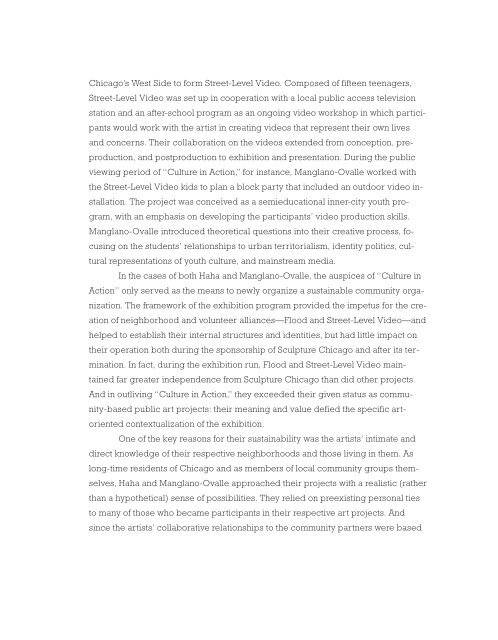ONE PLACE AFTER ANOTHER - Monoskop
ONE PLACE AFTER ANOTHER - Monoskop
ONE PLACE AFTER ANOTHER - Monoskop
Create successful ePaper yourself
Turn your PDF publications into a flip-book with our unique Google optimized e-Paper software.
Chicago’s West Side to form Street-Level Video. Composed of fifteen teenagers,<br />
Street-Level Video was set up in cooperation with a local public access television<br />
station and an after-school program as an ongoing video workshop in which participants<br />
would work with the artist in creating videos that represent their own lives<br />
and concerns. Their collaboration on the videos extended from conception, preproduction,<br />
and postproduction to exhibition and presentation. During the public<br />
viewing period of “Culture in Action,” for instance, Manglano-Ovalle worked with<br />
the Street-Level Video kids to plan a block party that included an outdoor video installation.<br />
The project was conceived as a semieducational inner-city youth program,<br />
with an emphasis on developing the participants’ video production skills.<br />
Manglano-Ovalle introduced theoretical questions into their creative process, focusing<br />
on the students’ relationships to urban territorialism, identity politics, cultural<br />
representations of youth culture, and mainstream media.<br />
In the cases of both Haha and Manglano-Ovalle, the auspices of “Culture in<br />
Action” only served as the means to newly organize a sustainable community organization.<br />
The framework of the exhibition program provided the impetus for the creation<br />
of neighborhood and volunteer alliances—Flood and Street-Level Video—and<br />
helped to establish their internal structures and identities, but had little impact on<br />
their operation both during the sponsorship of Sculpture Chicago and after its termination.<br />
In fact, during the exhibition run, Flood and Street-Level Video maintained<br />
far greater independence from Sculpture Chicago than did other projects.<br />
And in outliving “Culture in Action,” they exceeded their given status as community-based<br />
public art projects: their meaning and value defied the specific artoriented<br />
contextualization of the exhibition.<br />
One of the key reasons for their sustainability was the artists’ intimate and<br />
direct knowledge of their respective neighborhoods and those living in them. As<br />
long-time residents of Chicago and as members of local community groups themselves,<br />
Haha and Manglano-Ovalle approached their projects with a realistic (rather<br />
than a hypothetical) sense of possibilities. They relied on preexisting personal ties<br />
to many of those who became participants in their respective art projects. And<br />
since the artists’ collaborative relationships to the community partners were based

















